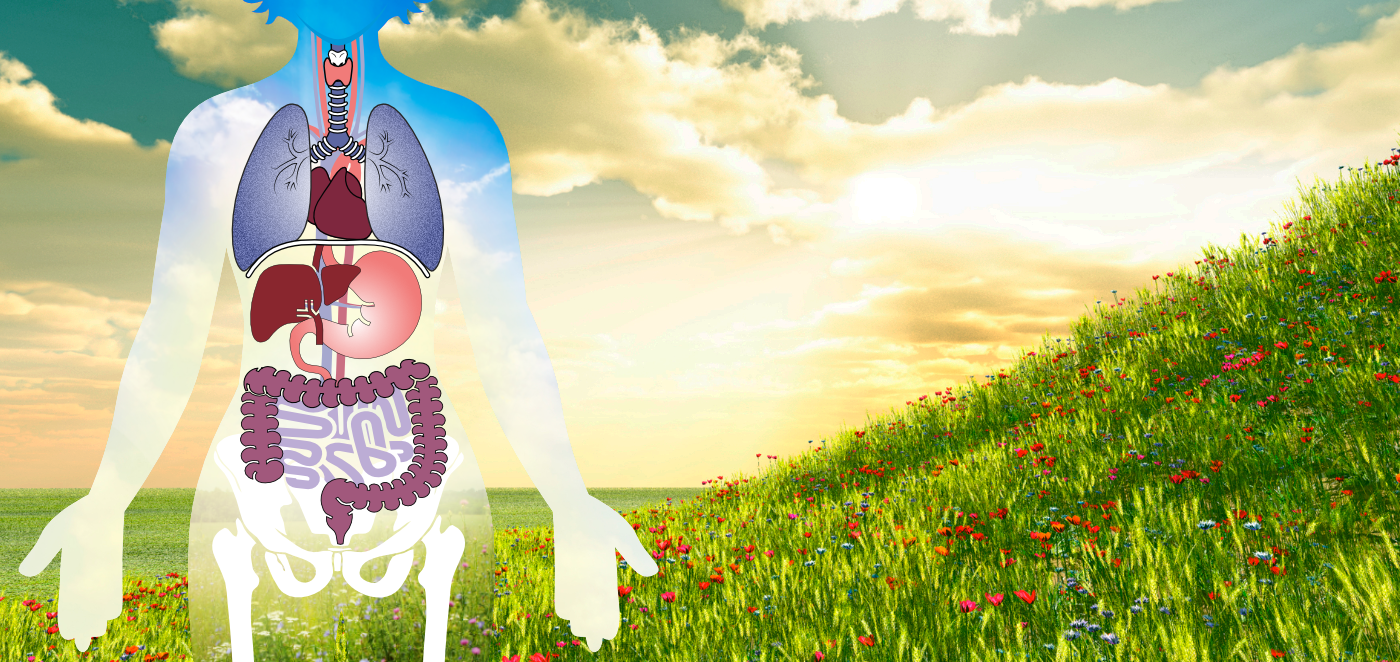The doshas’ impact on physiology: Body locations, functions, and common disorders

Every time I am about to fly, I get an upset stomach. It doesn’t matter how far I travel, how early I have to get up, how much work I need to complete, whether or not I am consciously stressed or worried; my body always reacts in the same predictable way. This reaction is just one manifestation of my vata reacting to a change in my routine since I don’t fly very often. This is a normal reaction from someone who has a vata-pitta constitution. It simply means that I am prone to hyperactivity of both vata and pitta. Either of those doshas is likely to become hyperactive in response to stress or whenever I need to adapt to a new challenge. Your way of adapting to your challenges might be different, but it is likely to manifest as an imbalance in your dominant dosha(s).
The word dosha means “fault,” “mistake,” or “imperfection,” although they are the natural forces that define our constitutional identity. Dr. Robert E. Svoboda, in his book Ayurveda for Women: A Guide to Vitality and Health, writes: “The doshas are paradoxically forces that both preserve an organism’s balance and rhythm when they are themselves balanced, yet will disturb its harmony when they are disturbed.”(1) We cannot perceive the doshas directly, as distinctive entities, but we can judge their relative balance or imbalance by the types of disturbances we experience within our bodies and minds.
Whenever you feel unwell, it is helpful to analyze your symptoms to figure out which dosha seems to be out of balance and requires attention. According to Robert Svoboda, “One useful general rule is: There is no pain without vata, no inflammation without pitta, and no pus formation without kapha. The greater the pain, the more vata is involved; the more fiery the inflammation, the angrier the pitta; the larger volume of pus, the greater the kapha” (1)
The three doshas permeate the body and are present in every cell, but they also have primary sites or locations within the body and are responsible for specific functions. Below is a brief list of the primary locations and functions of each dosha.
VATA is the body’s kinetic energy; it is produced through the digestion of food. Vata is in charge of movement of all types. It controls:

- Nerve impulses
- Retention and evacuation
- Circulation of blood and lymph
- Breathing
VATA LOCATIONS AND FUNCTIONS:
- Colon (where the food and water are processed and transformed into energy and nourishment)
- Head and neck (mental functions, balance)
- Chest and neck (vocal function, respiration, heart rhythm)
- Stomach (digestion, regulation of body fluids)
- Hollow organs, joints, and bone cavities (movement, circulation)
PHYSIOLOGICAL SYMPTOMS OF VATA IMBALANCE
Typical vata symptoms within the body usually have something to do with irregular movement:
- Increased movement (tachycardia, diarrhea, incontinence)
- Decreased movement (cramps, numbness, constipation, retention of urine)
- Disorganized movement (convulsions, tremors, arrhythmia, anxiety)
- Blocked movement (cysts, fibroid tumors, sciatica)
- Movement in the wrong direction, particularly with excretions (constipation, bloating)
- Separation of one tissue from another (prolapses, cracking of the skin).
PITTA is in charge of the body’s transformation processes; it controls the balance between kinetic and potential energy. Pitta is produced from the heat of blood. It controls the biochemistry and temperature and is responsible for:

- Mind and intellect
- Vision
- Digestion
- Skin color
- Hunger and thirst
PITTA LOCATIONS AND FUNCTIONS:
- Stomach and small intestine (digestion, assimilation)
- Liver, spleen (blood formation, color of lymph)
- Eyes (vision)
- Sweat and sebaceous glands (skin luster and temperature)
- Heart (blood pressure)
PHYSIOLOGICAL SYMPTOMS OF PITTA IMBALANCE
Typical pitta symptoms within the body usually have something to do with an increase in heat and irritation:
- Digestive irritation (indigestion, burning diarrhea, hyperacidity)
- Skin irritation (inflammation, burning sensations, rashes, ulcerations)
- Body temperature increase (fever)
- Blood flow and formation issues (bleeding disorders, anemia)
- Overactive body systems (hyperthyroidism, hypertension, jaundice)
- Inflamed tissues and organs (inflammation, hemorrhoids, infectious diseases)
KAPHA is the body’s reservoir of potential energy; it is the stabilizing force that keeps the entire organism connected, lubricated, and cohesive. It is produced through the plasma, which provides hydration and nourishment to all tissues. Kapha is responsible for:

- Shape and mass of the body
- Physical strength and endurance
- Overall structural stability
- All maintenance activities that keep the bodily systems running smoothly
- Hydration, lubrication, and nourishment of all tissues.
KAPHA LOCATIONS AND FUNCTIONS:
- Stomach, the main site of mucus production (lubrication, protection from germs)
- All other sites of mucus production (lungs, sinuses, mouth, throat, nose, and gastrointestinal tract).
- Chest (heart strength)
- Lymph (cell nourishment and fluid balance)
- Joints (stability and lubrication)
- Fat tissue (energy storage)
- Tongue (taste perception)
PHYSIOLOGICAL SYMPTOMS OF KAPHA IMBALANCE
Typical kapha symptoms within the body usually have something to do with an increase in dampness and density:
- Fluid retention (bloating, edema)
- Excessive tissue growth (benign tumors)
- Increase in density (respiratory congestion, excessive mucus, abundant phlegm, asthma)
- Increase in heaviness (obesity, diabetes, lethargy, heaviness of the body and limbs)
What does this mean in practical terms? How does this knowledge affect our own lives and our work with our students? Here is more on the practical application of this information >

Knowing your constitutional predispositions toward specific imbalances helps you avoid things that might aggravate the imbalance and correct it once it manifests.
References
- Ayurveda for Women: A Guide to Vitality and Health by Dr. Robert E. Svoboda (affiliate link)
- Yoga Therapy: A Guide to the Therapeutic Use of Yoga and Ayurveda for Health and Fitness by A.G. Mohan and Indra Mohan (affiliate link)
- Yoga and Ayurveda: Self-Healing and Self-Realization by David Frawley (affiliate link)
- The Chemistry of Joy: A Three-Step Program for Overcoming Depression Through Western Science and Eastern Wisdom by H. Emmons, M.D. (affiliate link)









